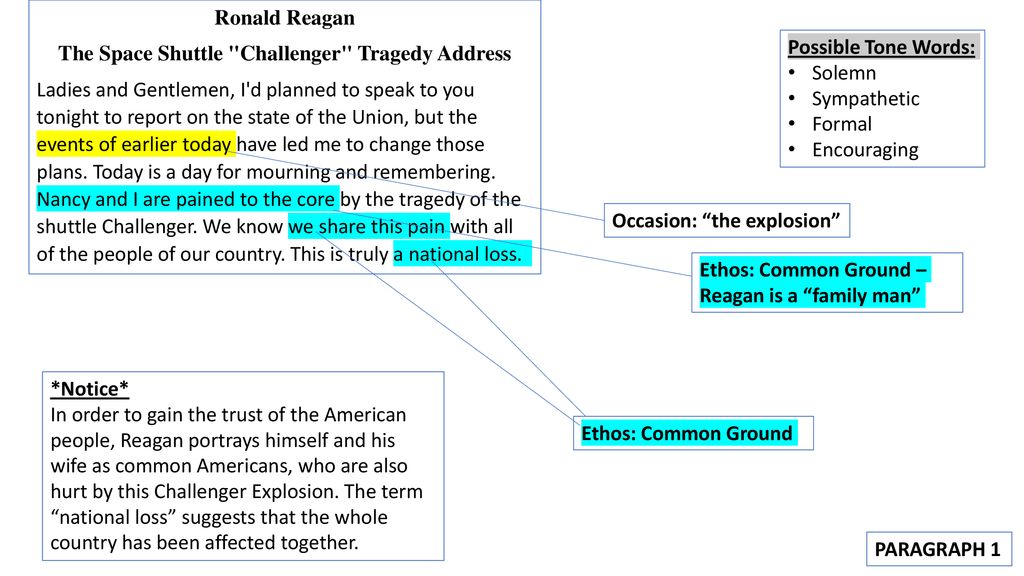The Space Shuttle “Challenger” Tragedy Address was an effective speech delivered by former President Ronald Reagan after the Space Shuttle Challenger disaster. This was a much-needed address after a difficult loss of seven crew members after just 73 seconds in flight. Reagan was arguably a great communicator, and this speech was just one of his many effective speeches in his time as the 40th president of the United States. Frankly, if pathos were a goldmine, Reagan would be the wealthiest man to have ever lived. The power to be persuasive or to appeal to an audience’s emotions takes great skill; at this particular time in history, Reagan was responding to the delicate emotions of a country in mourning. Throughout the speech, Reagan uses ethos, pathos, and logos to instill redemptive hope in his audience, especially those directly affected by the tragedy.
In the speech, Reagan begins by addressing the audience and communicating the purpose of the speech. The purpose is clearly brought in the first paragraph of the speech: “… I’d planned to speak to you tonight to report on the state of the Union, but the events of earlier today have led me to change those plans. Today is a day for mourning and remembering.” Reagan understands that the American nation is in shock and mourning, and thus asserts the importance of addressing the crisis that had just happened rather than going forward with his scheduled address on the State of the Union. This assertion of the implication of the tragedy not only to the victims or NASA but to the nation as a whole enhances his appeal to the audience’s emotions.
In addition to establishing a sense of purpose in his address, Reagan uses ethos to make his audience believe in the value and intensity of his empathetic message due to the presentation of his personality and morals. According to Stucki and Sager, it is possible to persuade the audience when an orator delivers the speech in a way as to render themselves worthy of trust (374). In this case, Reagan begins building trust in his audience by recalling a similar crisis that had happened 19 years before the current Challenger one, but insists that the later is by far the worst the nation had ever had in the Space program (Reagan pp. 2). To further his ethos validity, he goes ahead to mention the crew of the shuttle by name: “But they, the Challenger Seven, were aware of the dangers, but overcame them and did their jobs brilliantly. We mourn seven heroes: Michael Smith, Dick Scobee, Judith Resnik, Ronald McNair, Ellison Onizuka, Gregory Jarvis, and Christa McAuliffe” (Reagan pp. 3). This shows that the former President Reagan had done his homework and was aware of the facts and full information on the Challenger crew identity. He uses valid information to support his claim.
Along with his ethos appeals, Reagan used strong appeals to pathos specifically in the middle section of the speech. He calls out to the families of the deceased in a sympathetic manner, and creates an emotionally-charged moment where the audience can vividly feel the emotions. He says, “For the families of the seven, we cannot bear, as you do, the full impact of this tragedy. But we feel the loss, and we’re thinking about you so very much” (Reagan pp. 4). Undoubtedly, the audience feels that it is not a personal loss to those directly affected, but an nationwide pain that clearly identifies the intensity of the grief. By carefully choosing emotional phrases such as “we’re thinking of you so very much”, and “they had that special grace”, Reagan accomplished the goal of evoking emotions from the audience and ultimately succeeds in persuading the audience that the nation is deeply affected by the tragedy. Such emotionally charged words help establish the sadness from the crew’s demise and the impact it has on all stakeholders of the Space Program, including every America citizen.
A strong appeal to logos, which follows a logical progression of thoughts to support Reagan’s address, is also present in the speech. He states that the country has “grown used to wonders” and “for twenty-five years the United States space program has been doing just that” (Reagan pp. 6). In this case, the former President reminds his audience that they have come far in this journey, but it is only a beginning. He maintains that “We’re still pioneers”, hence the high probability for downfalls and shortcomings. In this approach, the orator’s application of logical arguments are key in effective persuasive strategies (Klingbeil, Russel and Stuckey 89).
From the analysis, it is clear that the effectiveness of Reagan’s rhetoric is primarily as a result of the masterful appeal to pathos, as well as ethos and logos in his statements. The former President Reagan begins his speech by effectively persuading his audience on the immense loss and sadness of the Challenger tragedy, and thereafter succeeds in showing his audience that there is still hope in country’s journey on space exploration. He artistically appeals to the audience’s ethos, pathos, and logos to comfort the friends and families of the deceased while also leaving a long-lasting message of hope and braveness in the audience.







